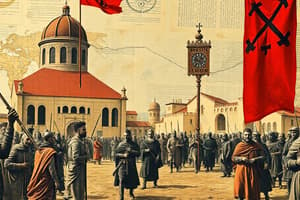Podcast
Questions and Answers
Who captured the Byzantine emperor Romanos Diogenes during the Battle of Manzikert?
Who captured the Byzantine emperor Romanos Diogenes during the Battle of Manzikert?
- The Crusaders
- The Byzantines
- The Ottoman Empire
- The Seljuk Turks (correct)
The Seljuk Turks took over Jerusalem in 1096.
The Seljuk Turks took over Jerusalem in 1096.
False (B)
What was the main reason Pope Urban II called for the Crusade?
What was the main reason Pope Urban II called for the Crusade?
To liberate Jerusalem and Christian holy sites from Muslim rule.
The first permanent Turkish settlement in Asia Minor was established in _____ near Constantinople.
The first permanent Turkish settlement in Asia Minor was established in _____ near Constantinople.
Match the following events with their corresponding dates:
Match the following events with their corresponding dates:
What was the reaction of the audience during Pope Urban II's speech?
What was the reaction of the audience during Pope Urban II's speech?
Byzantine Emperor Alexius I had a well-manned army that could defend against the Seljuk Turks.
Byzantine Emperor Alexius I had a well-manned army that could defend against the Seljuk Turks.
In which city did Pope Urban II deliver his influential speech calling for the Crusade?
In which city did Pope Urban II deliver his influential speech calling for the Crusade?
What was a significant outcome of Richard's negotiations with Salahuddin?
What was a significant outcome of Richard's negotiations with Salahuddin?
Salahuddin is remembered for his cruelty in battle and lack of compassion towards his enemies.
Salahuddin is remembered for his cruelty in battle and lack of compassion towards his enemies.
Who was the primary leader during the capture of Jerusalem in the late 12th century?
Who was the primary leader during the capture of Jerusalem in the late 12th century?
Who called for the Fourth Crusade?
Who called for the Fourth Crusade?
Salahuddin released King Guy de Lusignan without any conditions.
Salahuddin released King Guy de Lusignan without any conditions.
After Salahuddin's death, the Christians were hoping to take control of __________.
After Salahuddin's death, the Christians were hoping to take control of __________.
What city did Richard I capture before arriving in the Holy Land?
What city did Richard I capture before arriving in the Holy Land?
What mistake did Pope Innocent III realize regarding the Fourth Crusade?
What mistake did Pope Innocent III realize regarding the Fourth Crusade?
Match the following figures with their contributions during the Crusades:
Match the following figures with their contributions during the Crusades:
Salahuddin often wore a simple wool or linen ______.
Salahuddin often wore a simple wool or linen ______.
Match the leaders with their roles during the Crusades:
Match the leaders with their roles during the Crusades:
The Doge of Venice was supportive of the Fourth Crusade without any hidden agenda.
The Doge of Venice was supportive of the Fourth Crusade without any hidden agenda.
Zara was a maritime city that was the sole outlet for __________ trade.
Zara was a maritime city that was the sole outlet for __________ trade.
What was one of the conditions Richard I imposed for the surrender of Acre?
What was one of the conditions Richard I imposed for the surrender of Acre?
The fall of Jerusalem led to the unification of Muslims under Salahuddin.
The fall of Jerusalem led to the unification of Muslims under Salahuddin.
What was a significant consequence of Richard I's actions towards Muslim prisoners?
What was a significant consequence of Richard I's actions towards Muslim prisoners?
Flashcards
Seljuk Turks
Seljuk Turks
A group of Turkish tribes who conquered lands in Central Asia and the Middle East in the early 11th century.
Byzantine Empire
Byzantine Empire
The eastern continuation of the Roman Empire, centered in Constantinople (Istanbul).
Battle of Manzikert
Battle of Manzikert
A decisive Seljuk victory over the Byzantines in 1071, resulting in significant Byzantine losses and the opening of Anatolia to Turkish settlement.
Council of Clermont
Council of Clermont
Signup and view all the flashcards
First Crusade
First Crusade
Signup and view all the flashcards
Pope Urban II
Pope Urban II
Signup and view all the flashcards
Anatolia
Anatolia
Signup and view all the flashcards
Jerusalem
Jerusalem
Signup and view all the flashcards
Saladin's capture of Jerusalem
Saladin's capture of Jerusalem
Signup and view all the flashcards
Saladin's treatment of prisoners
Saladin's treatment of prisoners
Signup and view all the flashcards
Saladin's conquests after Jerusalem
Saladin's conquests after Jerusalem
Signup and view all the flashcards
Saladin's unification of Muslims
Saladin's unification of Muslims
Signup and view all the flashcards
Pope Gregory VIII's crusade
Pope Gregory VIII's crusade
Signup and view all the flashcards
Richard the Lionheart's actions
Richard the Lionheart's actions
Signup and view all the flashcards
Crusader base in Cyprus
Crusader base in Cyprus
Signup and view all the flashcards
Richard I's demands for Acre's surrender
Richard I's demands for Acre's surrender
Signup and view all the flashcards
Richard the Lionheart's Crusade
Richard the Lionheart's Crusade
Signup and view all the flashcards
Salahuddin's Legacy
Salahuddin's Legacy
Signup and view all the flashcards
Fourth Crusade's Diversion
Fourth Crusade's Diversion
Signup and view all the flashcards
Treaty between Richard and Salahuddin
Treaty between Richard and Salahuddin
Signup and view all the flashcards
Venetian Conspiracy
Venetian Conspiracy
Signup and view all the flashcards
Fourth Crusade Failure
Fourth Crusade Failure
Signup and view all the flashcards
Salahuddin's Death
Salahuddin's Death
Signup and view all the flashcards
Zara's Importance
Zara's Importance
Signup and view all the flashcards
Study Notes
The Crusades
- The Crusades were a series of religious wars between Christians and Muslims, primarily to control holy sites considered sacred by both groups.
- Eight major Crusade expeditions occurred between 1096 and 1291.
- These conflicts varied in size, strength, and degree of success, and significantly impacted the status of European Christians, making them major players in the fight for land in the Middle East.
Historical Context: Rise of Islam and the Byzantine Empire
- The rapid expansion of the Islamic caliphates in the 7th century brought Jerusalem and the Holy Land under Muslim control. Byzantine Empire (Eastern Roman Empire) had been a major power in the region, but faced threats from the Seljuk Turks.
Key Events in Jerusalem
- In 637 CE, Muslim armies captured Jerusalem from the Christians.
- Jerusalem is sacred to three religions: Islam, Judaism, and Christianity.
- Churches and synagogues were built without destroying existing places of worship.
- Jews and Christians were allowed to practice their religion freely.
- Christian and Jewish pilgrims were allowed to enter and worship peacefully, under the Umayyads and Abbasids.
The Umayyad Caliphate
- The Umayyad Caliphate was the first Muslim dynasty, founded in 661 CE and lasting until 750 CE.
- Initially established in disorder, the empire prospered and expanded over time.
Umayyads and Abbasids
- Umayyads and Abbasids were two families that became rulers of Islamic society
- Bani Umayyah was from the Quraysh family.
- The Abbasid Caliphate, ruling from Baghdad, flourished from 750 to 1258, promoting cultural and scientific growth during the Islamic Golden Age.
Seljuk Turks
- The Seljuks were a major branch of the Oghuz Turks.
- They formed a dynasty that ruled parts of Central Asia and the Middle East from the 11th to 14th centuries.
- They migrated from northern Iranian provinces in Central Asia into Persia.
- By the 11th century, they had formed a powerful empire in Persia.
Byzantine Empire under Seljuk Pressure
- The Seljuks' pressure on the Byzantine Empire occurred from approximately 1000 to 1200 CE.
- Constantinople was a major Byzantine city.
- The Seljuks played a pivotal role in shaping the Byzantine Empire during this period.
Further Crusades
- The Seljuks took over Jerusalem in 1076.
- In 1071, the Seljuks achieved a victory against the Byzantines in the Battle of Manzikert.
- In 1078, Seljuks took over Nicaea which was near Constantinople.
- In 1095, the Council of Piacenza saw the Byzantine emperor Alexius appeal to the Pope for help against Seljuk Turks.
- In 1095, Pope Urban II called a conference at Clermont, France; a very influential speech which gave rise to crusades.
- In 1099, Jerusalem was captured resulting in a brutal sack of the city.
- Four Crusader States were created: the kingdom of Jerusalem, the County of Edessa, the Principality of Antioch, and The County of Tripoli.
- Godfrey of Bouillon ruled Jerusalem between 1099-1100 and was succeeded by his brother Baldwin.
- Three reasons for failure of the First Crusade: Distance between Jerusalem and Baghdad, Disunity among Muslims, and Unpreparedness for war.
- Imaduddin Zangi, governor of Mosul and Aleppo, was a remarkable leader who unified the Muslims to regain lost territories.
- In 1144, Zangi recaptured Edessa which prompted a Second Crusade.
- The Second Crusade involved the Holy Roman Emperor, Conrad III, and French King Louis VII, and few other important nobles.
- The Seljuk Turks defeated the Second Crusade armies.
- The Kingdom of Jerusalem continued evolving with Arabic as the language of Christians, intermarriage with Arab Christians, increased trade with Muslims, and adoption of local dress.
- In 1146, Zangi was assassinated, but his successors continued to fight back against the crusaders and eventually helped recapture Damascus.
- In 1187, a large force under Salahuddin's leadership defeated the Frankish army at the Battle of Hattin.
- Salahuddin captured Jerusalem and was generous towards those he defeated; freed prisoners and negotiated a treaty.
- The Third Crusade, led by Richard I of England, saw a campaign with battles against the opposing forces resulting mostly in failure.
- The Fourth Crusade (1202-1204) didn't focus on Jerusalem. Instead, it was primarily driven by the Doge and other French who used the resources to divert to attack Constantinople and capture significant treasures.
- The 13th century saw 5 more crusades which failed to capture Jerusalem.
- In 1217, another crusade was called led by Andrew of Hungary, hoping to continue the Fourth Crusade's strategy.
- The Fifth Crusade (the siege and capture of Damietta)
- The Sixth Crusade (led by Frederick II, an unusual crusade with no pope involvement)
- The Seventh Crusade was undertaken by King Louis IX of France after he captured Damietta, was stranded for six months in the city due to the Nile floods. The troops' strength was greatly lowered and they lost in the battle of Mansura.
- The Eighth Crusade involved a futile attempt by King Louis IX to once again conquer a region. The King was taken ill and died soon after. The result was a partial success allowing Christians to live peacefully in the region.
Impact of Crusades
- The Crusades resulted in a new era in European civilization, introducing new ideas and ways of life.
- Many fruits, crops, plants, and other trade ideas were introduced to Europe.
- Refinement in dress, food, and domestic style were introduced to Europe.
- Architectural styles and construction methods were shared between different regions.
- The crusades helped to establish new trading routes.
Ottoman Empire
- The Ottoman Empire arose from the remnants of the Seljuk Turks following the fall of Mongol rule in Asia Minor.
- The Seljuk and Mongol Empires were not interested in the region, allowing for the emergence of a variety of independent Turkish states.
The City of Istanbul
- Major changes were made to Constantinople after the Ottoman conquest.
- Hagia Sophia was converted into a mosque.
- New mosques were built throughout the city.
- Aqueducts were built to maintain the city's water supply.
- The city's defences were repaired.
Cultural Life in Istanbul
- Coffee houses played a key role in the city's cultural life.
- Authors, artists, and craftsmen contributed to important cultural art forms.
- Notable contributions were realized in medicine, astronomy and geography.
Studying That Suits You
Use AI to generate personalized quizzes and flashcards to suit your learning preferences.





